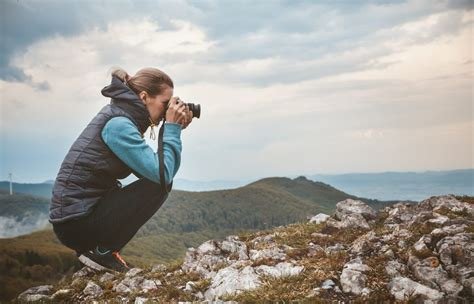Photography Basics: Tips for Capturing Stunning and Memorable Photos
Are you looking to take your photography skills to the next level? Whether you’re a beginner or have some experience behind the lens, understanding the basics of photography is essential for capturing stunning and memorable photos. In this blog post, we will explore everything from mastering camera settings to harnessing natural light and using different perspectives for unique shots. We’ll also delve into post-processing techniques to enhance your photos and tips for creating emotive visual stories. Whether you’re looking to improve your landscape photography or capture dynamic motion and striking images, these tips will help you take your photography to the next level. So grab your camera, and let’s dive into the world of photography basics to elevate your skills and capture unforgettable moments.
Understanding Camera Settings: A Beginner’s Guide
Understanding camera settings is crucial for anyone looking to improve their photography skills. Whether you’re a beginner or have some experience, knowing how to make the most of your camera’s settings can make a significant difference in the quality of your photos.
One key setting to understand is aperture, which controls the amount of light that enters the camera. A wider aperture (lower f-stop number) creates a shallower depth of field, while a smaller aperture (higher f-stop number) results in a greater depth of field, allowing more of the image to be in focus.
Shutter speed is another critical setting that influences how movement is captured in your photos. A fast shutter speed freezes motion, making it ideal for capturing fast-moving subjects, while a slow shutter speed can create a sense of motion and blur, perfect for conveying a feeling of movement in your images.
Lastly, ISO determines the camera sensor’s sensitivity to light. A lower ISO is suitable for bright conditions, while a higher ISO is useful in low-light situations. However, higher ISO settings can introduce unwanted noise or graininess to your photos, so finding the right balance is essential.
Mastering Composition Techniques for Striking Images
Mastering composition techniques is essential for creating visually impactful and striking images. Composition refers to the way elements are arranged within the frame of a photograph, and it plays a crucial role in determining the overall quality of an image. By understanding and implementing different composition techniques, photographers can elevate their work and create images that captivate and engage viewers.
One of the fundamental composition techniques for striking images is the rule of thirds. This technique involves dividing the frame into nine equal sections using two horizontal and two vertical lines. Placing key elements of the photograph along these lines or at their intersections can create a more balanced and visually appealing composition.
Another important composition technique is leading lines, which can be used to draw the viewer’s eye into the photograph and create a sense of depth and movement. Leading lines can be found in various forms such as roads, paths, fences, or natural elements like rivers or tree branches.
Additionally, paying attention to the use of negative space, framing, and symmetry can also contribute to the creation of striking images. Negative space, for example, can help to emphasize the main subject by providing a sense of scale and minimalism, while framing can be used to direct the viewer’s focus and add context to the image.
Harnessing Natural Light: Tips for Perfect Exposure
When it comes to photography, natural light can be one of the most powerful tools at your disposal. With the right techniques, you can capture stunning images with perfect exposure. Whether you’re shooting portraits, landscapes, or anything in between, harnessing natural light can make all the difference in the final result.
One of the key tips for achieving perfect exposure with natural light is to pay attention to the quality of the light. The time of day, weather conditions, and location can all impact the way natural light falls on your subject. By understanding how different types of natural light affect your photos, you can make the most of each situation.
Another important consideration when working with natural light is direction. The angle at which light hits your subject can create dramatic effects and enhance the overall mood of your image. Experimenting with front light, side light, and back light can help you find the perfect exposure for your photography.
In addition to quality and direction, managing natural light is essential for achieving perfect exposure. This can involve using reflectors to bounce light onto your subject, or diffusers to soften harsh sunlight. By controlling the way light interacts with your scene, you can create beautiful, well-exposed photographs that truly stand out.
Creative Use of Shadows and Highlights in Photography
When it comes to photography, the creative use of shadows and highlights can make a significant impact on the overall quality and mood of your images. Shadows and highlights can add depth, drama, and interest to your photos, and mastering their use can elevate your work to new heights.
One of the key techniques for utilizing shadows and highlights effectively is to pay attention to the direction and intensity of light. The angle of the light source can create different types of shadows, while the strength of the light can determine the contrast between shadows and highlights. Understanding how to manipulate these elements can help you create visually striking and memorable photographs.
In addition to paying attention to light, using shadows and highlights creatively often involves thinking about composition. By positioning your subject in relation to the light source, you can create dramatic silhouettes, interesting patterns, and captivating textures. Experimenting with different angles and perspectives can also help you find unique ways to incorporate shadows and highlights into your compositions.
Another essential aspect of using shadows and highlights creatively is post-processing. Editing software can be a powerful tool for fine-tuning the contrast, brightness, and saturation of your images, allowing you to emphasize or diminish shadows and highlights as needed. By mastering these editing techniques, you can take full control of the visual impact of shadows and highlights in your photography.
Exploring Depth of Field: Focus Techniques and Effects
Exploring depth of field in photography can open up a whole new world of creative possibilities. Understanding how to control focus techniques and utilize depth of field effects can take your photos to the next level.
One focus technique to consider is using a wide aperture (small f-stop number) to create a shallow depth of field. This can be particularly effective in portrait photography, as it allows you to isolate your subject and blur the background, resulting in a more visually striking image.
On the other hand, a small aperture (large f-stop number) can be used to achieve a greater depth of field, keeping both the foreground and background in focus. This technique is commonly used in landscape photography, where you want to capture the details of a scenic view.
Understanding the effects of depth of field can also help you convey a sense of depth and dimension in your photos. By mastering these focus techniques, you can guide the viewer’s eye to a specific point of interest, creating a more impactful and engaging image.
Capturing Motion: Freeze or Blur for Dynamic Photos
When it comes to capturing motion in photography, there are two main techniques that can be used to create dynamic and impactful images: freezing the motion or adding blur. Understanding how to use each of these techniques effectively can take your photography to the next level.
Freezing motion involves using a fast shutter speed to capture a moving subject in perfect clarity, without any blur. This technique is ideal for sports photography, wildlife photography, and any situation where you want to freeze the action and capture a moment in time.
On the other hand, adding blur to a photo can convey a sense of movement and energy. This can be achieved by using a slower shutter speed and intentionally moving the camera or allowing the subject to move within the frame. This technique is great for creating dynamic and artistic images, particularly in genres such as street photography and abstract photography.
Whether you choose to freeze or blur motion in your photos, the key is to experiment with different shutter speeds and techniques to find the right effect for your desired outcome. With practice, you can master the art of capturing motion in photography and create striking and dynamic images that truly stand out.
Using Different Perspectives for Unique and Engaging Shots
When it comes to photography, the perspective from which you capture a scene can make all the difference in creating unique and engaging shots. Whether you’re shooting a landscape, a portrait, or an architectural subject, choosing the right perspective can transform an ordinary image into something extraordinary.
One way to use different perspectives is to get down low and shoot from ground level. This can create a sense of drama and grandeur, especially when capturing tall buildings or towering trees. On the other hand, shooting from a higher vantage point can provide a bird’s eye view and reveal patterns and shapes that may not be immediately apparent from eye level. Playing with different angles can add an element of surprise and visual interest to your photographs.
Another technique for unique perspectives is to experiment with unconventional framing and composition. Instead of always centering your subject, try placing it off to the side or using leading lines to draw the viewer’s eye towards the focal point. Embracing negative space and incorporating asymmetry can also create a sense of balance and harmony in your compositions.
Lastly, don’t be afraid to get creative and think outside the box when it comes to perspective. Consider using reflections, shooting through objects, or experimenting with forced perspective to create visually arresting images that stand out from the crowd. By exploring different perspectives, you can elevate your photography and capture moments in ways that are truly memorable and emotive.
Choosing the Right Lens: An Essential Gear Guide
When it comes to photography, the right lens can make a world of difference in the quality and impact of your images. Whether you’re shooting portraits, landscapes, or action shots, selecting the appropriate lens is crucial for achieving professional results. There are various factors to consider when choosing a lens, including focal length, aperture, and the type of photography you’re interested in pursuing.
First and foremost, it’s essential to understand the concept of focal length. This determines the magnification and angle of view of the lens. A longer focal length, such as 85mm or 135mm, is ideal for portraits, as it allows you to capture detailed facial expressions without distortion. On the other hand, a shorter focal length, like 24mm or 35mm, is better suited for wide-angle shots, making it perfect for landscapes and architectural photography.
Next, aperture plays a significant role in selecting the right lens. A wide aperture, indicated by a smaller f-stop number, allows for more light to enter the lens, making it ideal for low-light conditions and creating a shallow depth of field for stunning bokeh effects in portrait photography. On the contrary, a narrower aperture, denoted by a higher f-stop number, is preferred for landscape photography, where you aim to capture sharp details from foreground to background.
Lastly, the type of photography you’re passionate about will help narrow down your lens choices. If you’re into sports and wildlife photography, a telephoto lens with a long focal length is essential for capturing distant subjects with precision. For macro photography enthusiasts, a dedicated macro lens that allows for extreme close-up shots is a must-have. Understanding these key factors will guide you in choosing the right lens for your specific photography needs, ensuring that your gear complements your creative vision and artistic expression.
Post-Processing Techniques to Enhance Your Photos
Post-processing is an essential part of digital photography, allowing photographers to enhance their images and bring out the best in their work. Whether you are a professional photographer or an amateur enthusiast, knowing how to properly post-process your photos can take your images to the next level.
One of the most important post-processing techniques is color correction. This involves adjusting the color balance, saturation, and contrast of an image to ensure that it accurately represents the scene as it appeared to the photographer. Whether you are shooting in raw or JPEG, color correction can help bring out the true colors of the image and make it more visually appealing.
Another crucial technique is cropping and straightening. Cropping allows you to remove distracting elements from the edges of your photo and focus on the main subject. It can also help you improve the composition of your image by adjusting the framing and aspect ratio. Straightening, on the other hand, is important for correcting any crooked horizons or tilted lines in your photos, giving them a more polished and professional look.
Sharpening and noise reduction are also important post-processing techniques that can greatly enhance the overall quality of your images. Sharpening helps to improve the clarity and definition of details, while noise reduction can eliminate any unwanted grain or digital noise that may be present in your photos. These techniques are especially important when working with low-light or high-ISO images, where noise and softness can be more pronounced.
Tips for Creating Memorable and Emotive Visual Stories
When it comes to creating memorable and emotive visual stories through photography, one of the most important tips is to focus on the emotions and experiences you want to convey. Take the time to think about the message you want to communicate through your images, and use composition, lighting, and subject matter to evoke a specific feeling in your viewers.
Another key tip is to pay attention to the details in your visual stories. Whether it’s a subtle expression on a person’s face, a small object in the background, or a specific texture in the environment, these details can add depth and meaning to your images, making them more memorable and emotive.
Furthermore, don’t be afraid to experiment with different perspectives and angles to capture your visual stories in unique and engaging ways. By exploring different vantage points and viewpoints, you can create photos that are not only visually stunning but also deeply meaningful and inspiring.
Lastly, post-processing techniques can be used to enhance the mood and emotion in your visual stories. Whether it’s adjusting the contrast, adding a subtle color tone, or emphasizing specific elements, post-processing can help bring out the emotions and impact of your images, making them more memorable and emotive.
Frequently Asked Questions
What are some basic photography tips for beginners?
Understanding Camera Settings: A Beginner’s Guide provides essential tips for beginners to grasp the basics of camera settings and how to use them effectively.
How can I improve the composition of my photos?
Mastering Composition Techniques for Striking Images offers valuable insights and techniques to improve the composition of your photos.
What are some tips for capturing photos in natural light?
Harnessing Natural Light: Tips for Perfect Exposure provides useful tips for utilizing natural light to achieve the perfect exposure in your photos.
How can I use shadows and highlights creatively in my photography?
Creative Use of Shadows and Highlights in Photography offers innovative ways to use shadows and highlights to enhance your photos.
What are some techniques for achieving different depth of field effects?
Exploring Depth of Field: Focus Techniques and Effects explores various techniques for achieving different depth of field effects in your photos.
How can I capture dynamic photos with motion blur or freeze techniques?
Capturing Motion: Freeze or Blur for Dynamic Photos provides insights into capturing dynamic photos using motion blur or freeze techniques.
What are some tips for using different perspectives in photography?
Using Different Perspectives for Unique and Engaging Shots offers tips for using different perspectives to capture unique and engaging photos.






